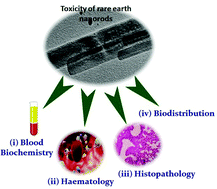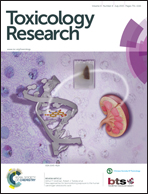Toxicological assessment of PEG functionalized f-block rare earth phosphate nanorods†
Abstract
The emerging development of rare earth nanotechnology in daily science has aroused serious concerns regarding its impact on health care systems. Despite the potential uses of rare earth (RE) nanoparticles for targeted drug delivery, detection/diagnosis and imaging, potential nanoparticle toxicity must be investigated before any in vivo medicinal applications can move forward. In this account, we illustrate the toxicological assessment of polyethylene glycol (PEG) functionalised Ln3+ (Ce3+, Tb3+) doped rare earth phosphate (LaPO4) nanorods. The first part of the work describes the synthesis of the nanorods employing a biologically compatible reaction environment using a H2O–EtOH solvent mixture, reflux temperature and a ligand exchange methodology. Thereafter, the synthesized materials have been purified and characterized. The later part of the work discusses the in vivo toxicity of the nanomaterial. Synthesized nanorods were suspended in a buffer and administered to mice through intraperitoneal (IP) injection over a period of 7 days (high dose 125 mg kg−1) and 28 days (high dose 125 mg kg−1 and low dose 12.5 mg kg−1). Analysis of the serum biochemistry and haematology followed by histopathology indicates inflammation in the liver. The biodistributions of rare earth ions (La3+, Ce3+ and Tb3+) were analyzed using inductively coupled plasma mass spectrometry (ICPMS). Additionally, cellular viability of the synthesized nanorods was also studied using spleen mononuclear cells of Swiss albino mice.


 Please wait while we load your content...
Please wait while we load your content...